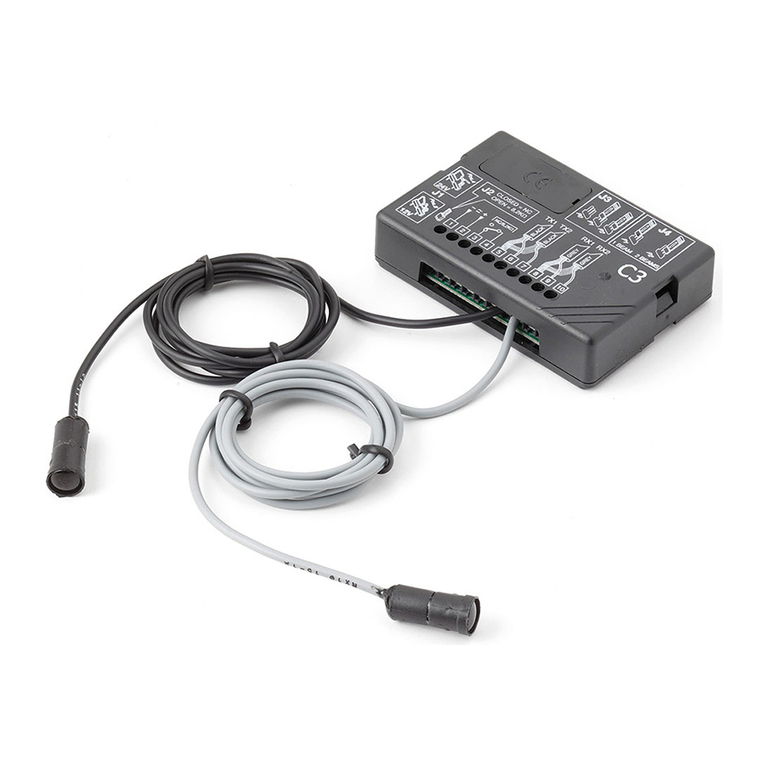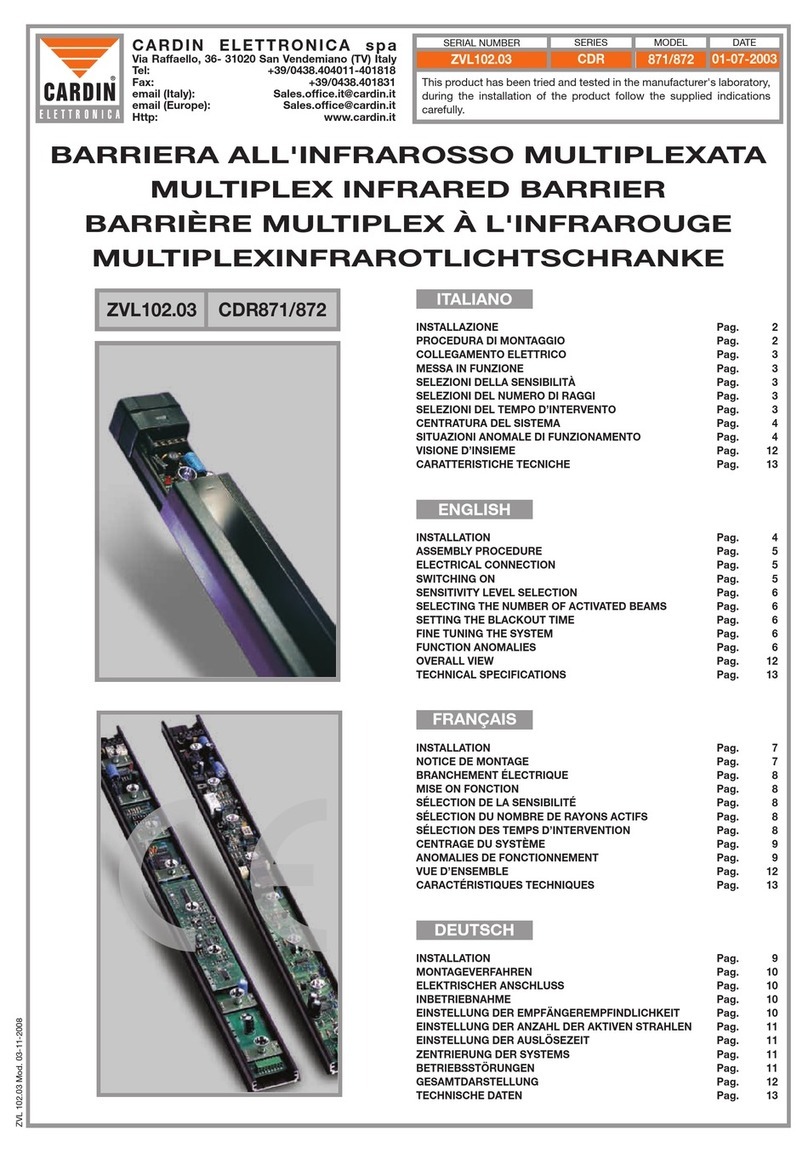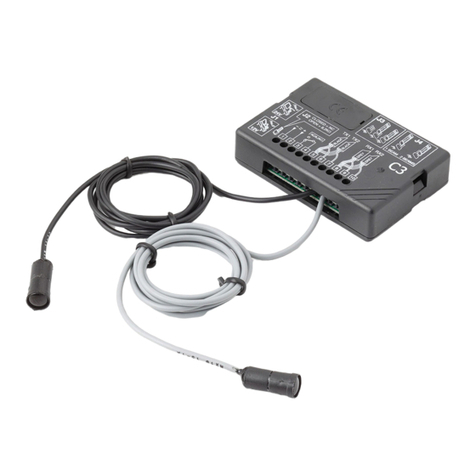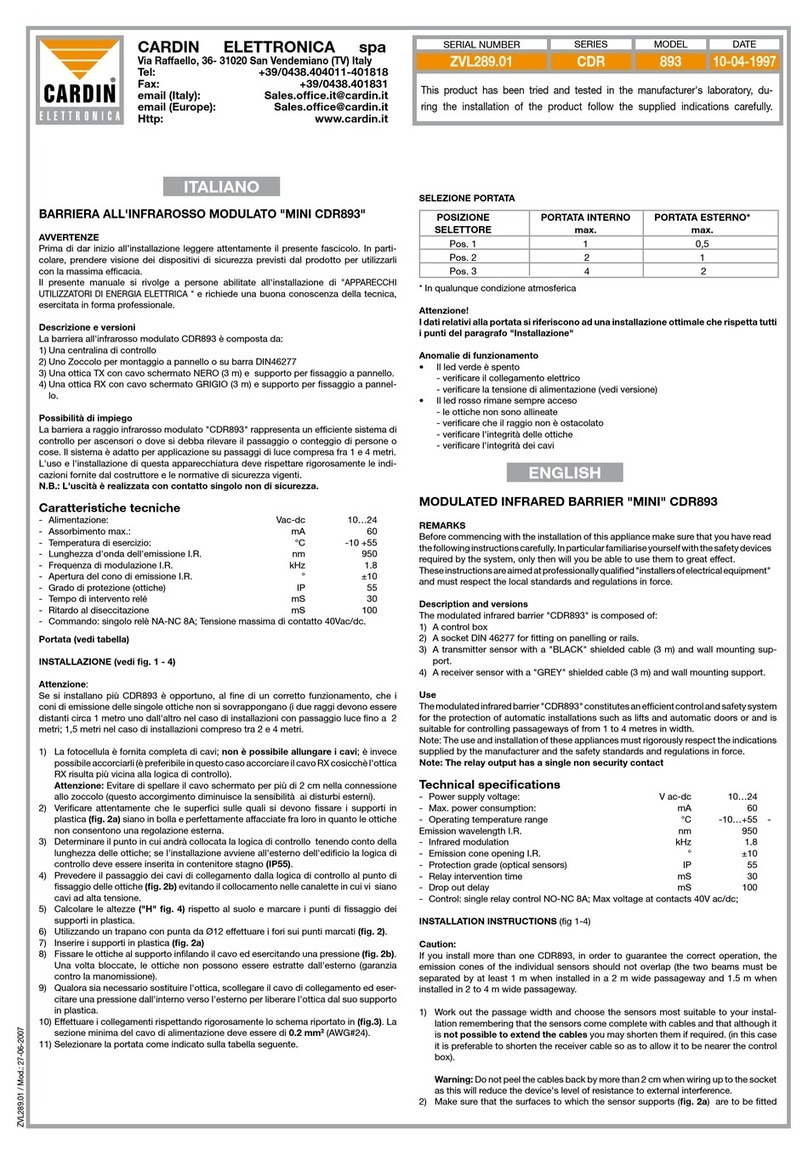
DEUTSCH
MODULIERTE INFRAROTLICHTSCHRANKE "MINI FTR893C3"
Hinweis:Das vorliegende Handbuch wendetsich an Personen, die zur Installation von "ELEKTROGERÄ-
TEN" befähigt sind und setzt eine gute beruiche Kenntnis der Technik voraus. Bevor mit der Installation
begonnen wird, sollte das vorliegende Heft aufmerksam gelesen werden. Insbesondere sollten die vom
Produkt vorgesehenen Sicherheitseinrichtungen zwecks bester Efzienz in Augenschein genommen
werden. Gerät der Klasse 3 mit doppeltem Relais mit Umschaltungen in Serie, der NC-Kontakt entspricht
den Vorschriften der Kategorie 3 der UNI EN ISO 13849-1 (Aktualisierung der EN954-1).
Achtung! Nur für EG-Kunden – WEEE-Kennzeichnung.
Das Symbol zeigt an, dass das Produkt am Ende seines Lebenszyklus getrennt von
anderen Abfällen gesammelt werden muss. Der Benutzer muss daher das Gerät in
geeignete Zentren für die getrennte Sammlung von Elektronik- und Elektroschrott brin-
gen oder zum Zeitpunkt des Erwerbs eines neuen Geräts gleicher Art im Verhältnis eins
zu eins beim Händler abgeben. Die geeignete getrennte Sammlung für die Zuführung
zum Recycling, zur Aufbereitung und zur umweltfreundlichen Entsorgung trägt dazu bei, mögliche
negative Auswirkungen auf die Umwelt und die Gesundheit zu vermeiden und fördert das Recycling
der Materialien. Die widerrechtliche Entsorgung des Produkts durch den Besitzer führt zur Anwendung
der von den geltenden Vorschriften im Mitgliedstaat der Europäischen Gemeinschaft vorgesehenen
Verwaltungsstrafen.
Die modulierte Infrarotlichtschranke "FTR893C3", besteht aus:
1) Der Kontrollzentrale FTR893C3;
2) Ein Sender Optik mit SCHWARZEM abgeschirmten Kabel und Träger zur Befestigung an
der Fläche.
3) Ein Empfänger Optik mit GRAUEM abgeschirmten Kabel und Träger zur Befestigung an der
Fläche.
Ausführung Sender Kabellänge (Schwarz)Empfänger Kabellänge(Grau)
FTR893C3 4 m 4 m
Einsatzmöglichkeiten
Die Infrarotlichtschranke "FTR893C3" stellt ein wirksames Sicherheitssystem zum Schutz
von Durchgängen oder Flächen bei denen automatische Installationen von Aufzügen dar.
Sie ist geeignet für Durchgänge mit einer Weite zwischen 0,5 und 2,5 m innerhalb von
Gebäuden. Die Verwendung und die Installation dieser Geräte muss unter der genauen
Befolgung der vom Hersteller gegebenen Anweisungen und der geltenden Sicherheitsbe-
stimmungen erfolgen.
Installation (siehe Abb. 1 - 4)
Achtung!Wenn mehrere FTR893C3installiert werden,dürfen sich die Strahlungskegelder
einzelnen Optiken nicht überlagern, um eine korrekte Funktionsweise zu gewährleisten.
Die beiden Lichtstrahlen müssen einen Abstand voneinander von zirka 1,5 m schaltet
werden.
1) Die Optiken sind komplett mit ihren Kabeln geliefert; ein Verlängern der Kabel ist nicht mög-
lich; sie können aber verkürzt werden (in diesem Fall ist die Verkürzung des Empfängerkabels
vorzuziehen, so dass die Optik des Empfängers näher zur Kontrollogik kommt).
Achtung: Vermeiden Sie, das abgeschirmte Kabel auf mehr als 2 cm beim Anschluss an die
Klemmleiste der Kontrollogik abzuisolieren (dies verringert die Empfänglichkeit gegenüber
Störungen von außen).
2) Prüfen Sie aufmerksam, ob die Oberächen, auf denen die Plastikhalter befestigt werden sollen
(Abb. 3a), waagerecht sind und sich perfekt gegenüberliegen, da die Optiken nicht von außen
eingestellt werden können.
3) Bestimmen Sie die Stelle, an der die Kontrollogik untergebracht werden soll, wobei Sie sich die
Kabellänge der zu Verfügung stehenden Optiken vor Augen halten sollten. Wenn die Installation
außerhalb des Gebäudes erfolgt, muss die Kontrollogik in einem wetterdichten Gehäuse (IP55)
untergebracht werden.
4) Bereiten Sie den Verlauf der Verbindungskabel von der Kontrollogik bis zur Befestigungsstelle
derOptiken(Abb.3b) vor, wobei dasZusammenlegenmitStarkstromkabelnindenKabelkanälen
vermieden werden sollte.
5) Berechnen Sie die Höhen vom Boden ("H" Abb. 2) und markieren Sie die Befestigungspunkte
der Plastikhalter.
6) Mit einem Bohrer, der mit einer Bohrspitze Ø12 ausgestattet ist, bohren Sie die Löscher an
den markierten Punkten (Abb. 2).
7) Setzen Sie die Plastikhalter ein (Abb. 3a).
8) Befestigen Sie die Optiken am Träger, indem Sie das Kabel einführen und Druck ausüben (Abb.
3b). Nachdem die Optiken befestigt sind, können sie von außen nicht mehr herausgezogen
werden (Garantie gegen Mißgriffe).
9) Falls eine Ersetzung der Optik notwendig werden sollte, lösen Sie das Verbindungskabel und
üben Sie Druck von innen nach außen aus, um die Optik aus ihrer Plastikhalterung zu befreien.
10) Führen Sie die Anschlüsse aus, wobei Sie rigoros das in der (Abb.4) wiedergegebene Schema
befolgen. Der Durchmesser des Stromversorgungskabels sollte mindestens 0,2 mm2betragen
(AWG#24).
11) Die Art des Kontakts im Ausgang auswählen: NC/8.2 kΩ.
12) Wie in der Tabelle auf Seite 4 angegeben die Reichweite auswählen, wobei darauf zu achten
ist, dass sich die Daten für die Reichweite auf eine optimale Installation beziehen, die alle
Punkte des Abschnitts "Installation" erfüllt.
Betriebsstörungen
• Die grüne Led leuchtet nicht.
- Überprüfen Sie den elektrischen Anschluss.
- Den Wert und die Polarität der Versorgungsspannung
(12/24 Vac/dc)
überprüfen.
• Die rote Led leuchtet dauernd.
- Die Optiken sind nicht ausgerichtet
- Überprüfen Sie, ob der Lichtstrahl behindert wird;
- Überprüfen Sie die Unversehrtheit der Optiken;
- Überprüfen Sie die Unversehrtheit der Kabel.
FRANÇAIS DEUTSCH
BARRIERE A INFRAROUGE MODULE "MINI FTR893C3"
Remarque: Ce livret est destiné à des personnes titulaires d’un certicat d’aptitude professionnelle
pour l’installation des "APPAREILS ÉLECTRIQUES" et requiert une bonne connaissance de la tech-
nique appliquée professionnellement. Avant de procéder à l’installation, lire attentivement ce livret.
En particulier, se familiariser avec les dispositifs de sécurité prévus sur le produit an de pouvoir les
utiliser au mieux.
Appareil de classe 3 à double relais avec contact inverseur en série. Le contact N.F. est conforme aux
normes de la catégorie 3 de la UNI EN ISO 13849-1 (mise à jour de la EN954-1).
Attention! Seulement pour les clients de l'EU - Marquage WEEE. Ce symbole indique
l’obligation de ne pas éliminer l’appareil, à la n de sa durée de vie, avec les déchets
municipaux non triés et de procéder à sa collecte sélective. Par conséquent, l’utilisateur
doit remettre l’appareil à un centre de collecte sélective des déchets électroniques et
électriques ou au revendeur qui est tenu, lorsqu’il fournit un nouvel appareil, de faire en
sorte que les déchets puissent lui être remis, sur une base de un pour un, pour autant que
l’appareil soit de type équivalent à celui qu’il fournit. La collecte sélective des équipements électriques et
électroniques en vue de leur valorisation, leur traitement et leur élimination dans le respect de l’environnement
contribue à éviter la nocivité desdits équipements pour l’environnement et pour la santé et à encourager
leur recyclage. L’élimination abusive de l’équipement de la part du détenteur nal comporte l’application
des sanctions administratives prévues par les normes en vigueur dans l’État Membre d’appartenance.
La barrière à l’infrarouge modulé "FTR893C3" est constituée de:
1) la centrale de contrôle FTR893C3;
2) une tête optique TX munie de câble blindé NOIR et de support de xation sur panneau;
3) une tête optique RX munie de câble blindé GRIS et de support de xation sur panneau.
Version Longueur câble TX (Noir)Longueur câble RX (Gris)
FTR893C3 4 m 4 m
Applications possibles (voir fig.1 - 4)
La barrière à l’infrarouge modulé "FTR893C3" est un système de sécurité efcace, conçu pour
la protection de passages ou d’endroits destinés à des installations automatisées d’ascenseurs.
Le système est indiqué pour des passages d’une dimension comprise entre 0,5 et 2,5 m à
l'intérieur des bâtiments.
Pour l’utilisation et l’installation de cet appareil, se conformer aux indications fournies par le
Constructeur et aux normes de sécurité en vigueur.
Installation (voir fig.1 - 4)
Attention! En cas d’installation de plusieurs FTR893C3, il est nécessaire pour obtenir un
bon fonctionnement que les cônes d’émission des têtes optiques ne se chevauchent pas
et les deux faisceaux doivent être distants l’un de l’autre de 1,5 m environ.
1) Les têtes optiques sont fournies munies de câbles; il n’est pas possible de rallonger les
câbles. Ceux-ci peuvent par contre être raccourcis (dans ce cas il est conseillé de raccourcir
le câble RX de façon que la tête optique RX soit plus proche de la logique de contrôle).
Attention: éviter de dénuder le câble blindé de plus de 2 cm dans la connexion du bornier
de la logique de contrôle (ceci réduit la sensibilité aux parasites).
2) Vérier soigneusement que les surfaces qui reçoivent les supports en plastique (fig.3a)
soient à niveau et parfaitement alignées l’une par rapport l’autre, considéré que les têtes
optiques ne permettent pas un réglage de l’extérieur.
3) Déterminer l’emplacement de la logique de contrôle en tenant compte de la longueur des
têtes optiques à disposition.
En cas d’installation à l’extérieur de l’édice, la logique de contrôle doit être logée dans un
boîtier étanche (IP55).
4) Prévoir le passage des câbles de branchement de la logique de contrôle jusqu’au point
de xation des têtes optiques (fig. 3b). Éviter de les faire passer dans des conduites dans
lesquelles se trouvent des câbles haute tension.
5) Calculer les hauteurs ("H" fig. 2) par rapport au sol et tracer les points de xation des
supports en plastique.
6) Utiliser une perceuse et un forêt de Ø12 pour pratiquer les trous aux endroits tracés (fig. 3).
7) Fixer les supports en plastique (fig. 3a).
8) Enler le câble et xer les têtes optiques au support en exerçant une certaine pression (fig.
3b). Une fois xées, les têtes optiques ne peuvent pas être extraites de l’extérieur (sécurité
contre les risques de vandalisme).
9) En cas de remplacement d’une tête optique, débrancher le câble de branchement et exercer
une pression de l’intérieur vers l’extérieur pour la dégager de son support en plastique.
10) Effectuer le branchement en observant scrupuleusement le schéma reporté en (fig. 4). La
section minimale du câble d’alimentation doit être de 0,2 mm2(AWG#24).
11) Sélectionner le type de contact en sortie: NC/8.2 kΩ
12) Sélectionner la portée suivant les indications du tableau de la page 4 en sachant que les
données inhérentes à la portée sont valables pour une installation optimale qui satisfait
tous les points du paragraphe "Installation".
Anomalies de fonctionnement
• Le led vert est éteint:
- vérier le branchement électrique;
- contrôler la valeur et la polarité de la tension d’alimentation
(12/24 Vac/dc).
• Le led rouge reste toujours allumé.
- vérier que les têtes optiques sont bien alignées
- vérier que le faisceau ne soit pas interrompu;
- vérier l’intégralité des têtes optiques;
- vérier l’intégralité des câbles.



























